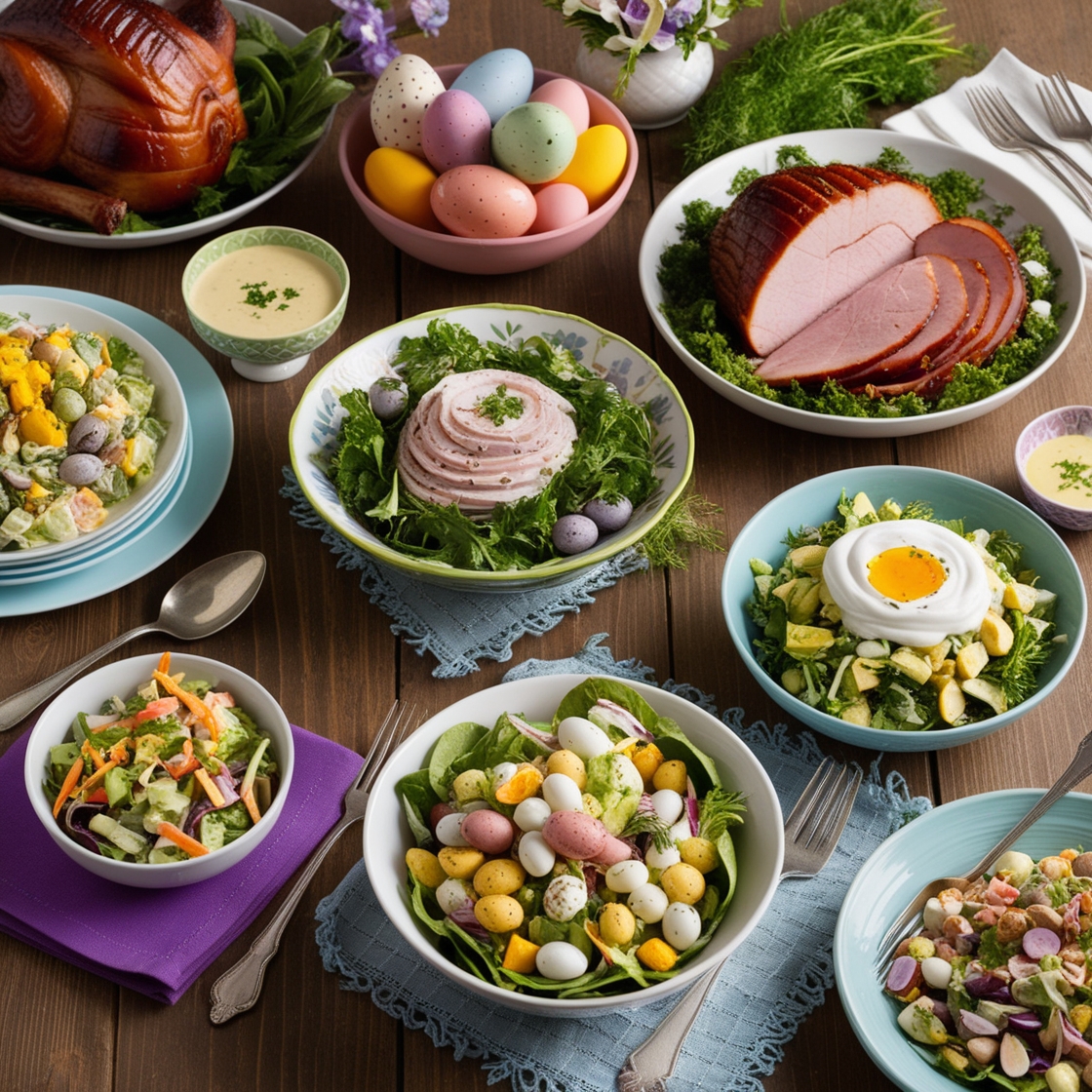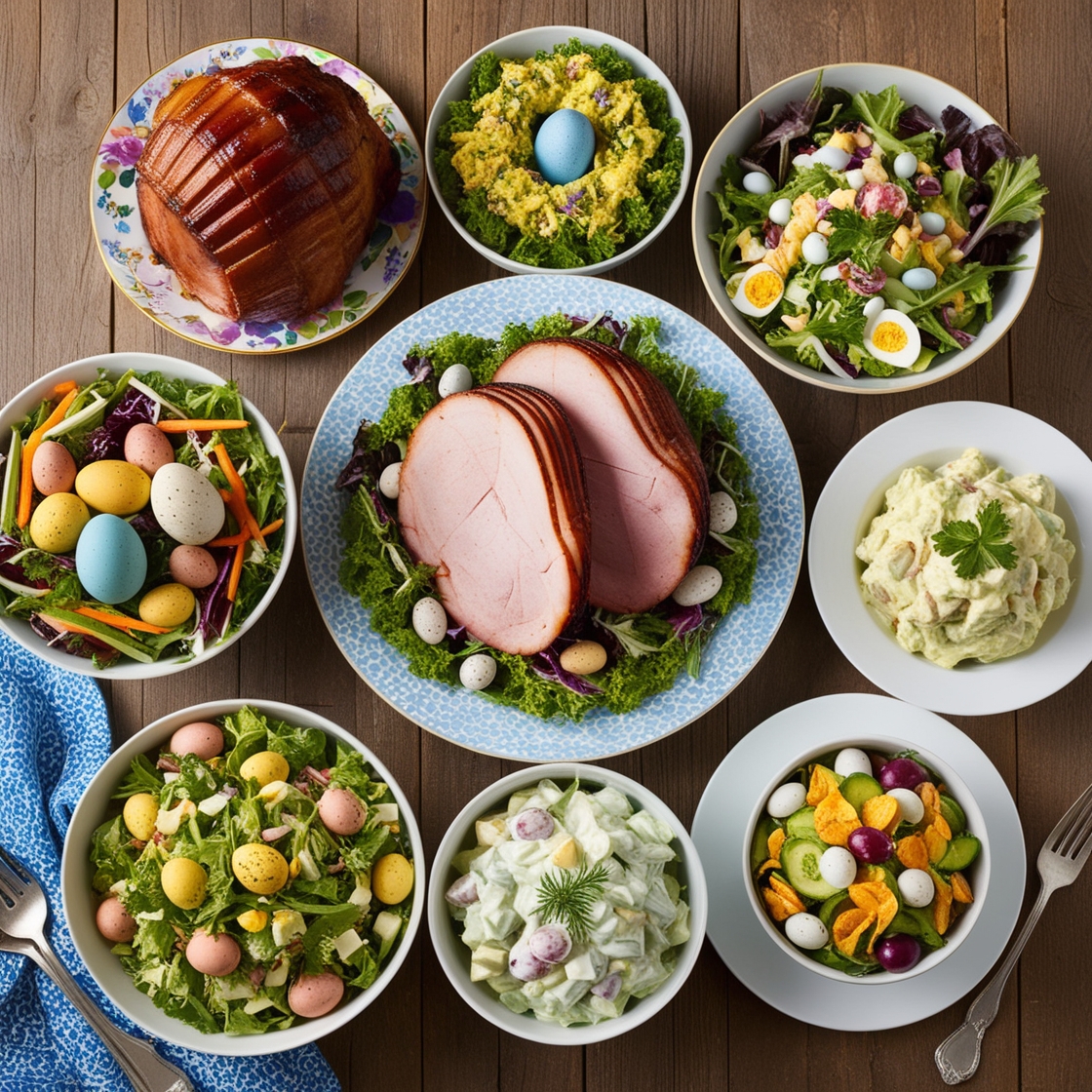Easter, a festive celebration that signifies renewal and new beginnings, is traditionally marked by gathering with family and friends over a delicious meal. Beyond the rich roasts, baked hams, and Easter eggs, salads play a crucial role in balancing the feast with their refreshing and wholesome qualities. Traditional Easter salads not only add a burst of vibrant color to your table but also offer diverse flavors and textures, from crunchy vegetables to creamy dressings. In this article, we’ll dive deep into the history, nutritional benefits, classic ingredients, and popular recipes of traditional Easter salads. Additionally, we’ll provide step-by-step instructions, answer common questions, and share tips to make your Easter salads the highlight of your feast.
1. Nutritional Value of Traditional Easter Salads
Traditional Easter salads are known for their fresh and healthy ingredients, which provide numerous health benefits. Depending on the types of salads you prepare, the nutritional value can vary, but overall, they are packed with essential vitamins, minerals, fiber, and proteins that support a healthy body.
- Fiber: Vegetables like carrots, cucumbers, radishes, and leafy greens are rich in dietary fiber, which helps in maintaining healthy digestion, lowering cholesterol levels, and regulating blood sugar. Including fiber-rich foods in your diet is especially beneficial after consuming richer, heavier dishes commonly found at Easter feasts.
- Vitamins and Antioxidants: Salads featuring a variety of colorful vegetables provide essential vitamins and antioxidants. For example, tomatoes and bell peppers are rich in vitamin C, which strengthens the immune system and helps in skin repair. Dark leafy greens like spinach and kale are excellent sources of vitamin A and K, which promote good vision and bone health.
- Protein: Many traditional Easter salads include protein sources such as eggs, ham, chicken, or seafood. Eggs, a staple of Easter celebrations, are particularly rich in high-quality protein, essential amino acids, and nutrients like vitamin B12 and selenium. Adding protein to your salads ensures they are not only light but also filling.
- Healthy Fats: Some Easter salad dressings use olive oil, avocado, or nuts, which are excellent sources of heart-healthy monounsaturated fats. These fats help to reduce inflammation, improve cholesterol levels, and provide lasting energy for your body. Additionally, they enhance the absorption of fat-soluble vitamins found in the vegetables.

2. Popular Traditional Easter Salads and Ingredients
There are numerous variations of traditional Easter salads depending on regional and family preferences. Below are three popular traditional Easter salads that are commonly found at Easter feasts. Each has its own unique blend of flavors and ingredients, making them perfect complements to your Easter meal.
A. Deviled Egg Salad
Deviled eggs are an Easter classic, but transforming them into a creamy, flavorful salad takes them to another level. This salad can be served as a side dish or a filling for sandwiches.
Ingredients:
- 6 hard-boiled eggs, peeled and chopped
- 1/4 cup mayonnaise (or Greek yogurt for a healthier option)
- 1 tbsp Dijon mustard
- 1 tsp apple cider vinegar
- 1 tsp sweet relish (optional)
- Salt and pepper to taste
- Paprika and chopped chives for garnish
Nutritional Value:
- Calories: 150 per serving
- Protein: 10g
- Healthy fats: 12g
B. Spring Vegetable Salad
This vibrant salad takes full advantage of the fresh, seasonal produce available during Easter. It’s light, refreshing, and bursting with natural flavors.
Ingredients:
- 2 cups mixed greens (arugula, spinach, and baby kale)
- 1/2 cup sliced radishes
- 1/2 cup chopped carrots
- 1/4 cup green peas (fresh or frozen)
- 1/4 cup diced cucumbers
- 2 tbsp chopped fresh dill or parsley
- Olive oil and lemon vinaigrette (2 tbsp olive oil, 1 tbsp lemon juice, salt, and pepper)
Nutritional Value:
- Calories: 120 per serving
- Fiber: 4g
- Vitamin C: 45% of daily recommended intake
C. Easter Ham and Potato Salad
This hearty salad is often enjoyed as a side dish or even a main course at Easter brunch. Combining tender potatoes with savory ham and a creamy dressing, it’s a family favorite that can be prepared ahead of time.
Ingredients:
- 2 cups boiled potatoes, cubed
- 1 cup diced cooked ham
- 1/4 cup chopped scallions
- 1/4 cup sour cream
- 1 tbsp Dijon mustard
- 1/4 cup chopped pickles (optional)
- Salt and pepper to taste
Nutritional Value:
- Calories: 250 per serving
- Protein: 15g
- Potassium: 400mg

3. Step-by-Step Recipe for Traditional Easter Ham and Potato Salad
The following recipe breaks down the process of making Easter Ham and Potato Salad, a perfect combination of rich flavors and satisfying textures.
Step 1: Prepare the Potatoes
Begin by boiling your potatoes in salted water until they are tender but not mushy. Drain the potatoes and allow them to cool completely before cutting them into bite-sized cubes.
Step 2: Prepare the Ham
While the potatoes are cooling, dice your cooked ham into small cubes. If you have leftover ham from the Easter dinner, this is a great way to repurpose it.
Step 3: Mix the Salad Ingredients
In a large mixing bowl, combine the cubed potatoes, diced ham, scallions, and pickles (if using). Add the sour cream and Dijon mustard for creaminess and a tangy flavor profile. Season the salad with salt and freshly ground black pepper to taste.
Step 4: Chill the Salad
Cover the salad with plastic wrap and refrigerate for at least 30 minutes before serving. This allows the flavors to meld together and creates a refreshing dish that pairs well with other Easter mains.
Step 5: Garnish and Serve
Before serving, garnish the salad with chopped parsley or additional scallions for a fresh pop of color. Serve cold as a side dish or enjoy it on its own.
4. Frequently Asked Questions (FAQs) about Traditional Easter Salads
Q1: Can I prepare Easter salads ahead of time?
Absolutely! Many Easter salads taste even better when made ahead of time. You can prepare the salads up to a day before your Easter feast. Simply store them in airtight containers in the refrigerator. Just be sure to add the dressing right before serving to keep the salad fresh and crisp.
Q2: What are good vegetarian options for Easter salads?
For a vegetarian twist, try substituting meat-based ingredients like ham or chicken with plant-based proteins such as chickpeas, tofu, or quinoa. Additionally, roasted vegetables like butternut squash or sweet potatoes can be added for a hearty, vegetarian-friendly option.
Q3: What is the best dressing to use for Easter salads?
A light vinaigrette made with olive oil and lemon juice works beautifully with most Easter salads. For creamier salads, consider using sour cream, Greek yogurt, or mayonnaise-based dressings. You can also experiment with fresh herbs and spices like dill, basil, and thyme to enhance the flavor of the dressing.
Q4: Can I freeze Easter salads?
It’s generally not recommended to freeze Easter salads, especially those with creamy dressings or fresh vegetables. Freezing can cause the texture of the salad to become mushy when thawed. It’s best to enjoy Easter salads fresh or store leftovers in the fridge for up to 2-3 days.
5. Tips for Perfecting Traditional Easter Salads
- Use Seasonal Ingredients: Easter falls in early spring, so take advantage of fresh, in-season vegetables like asparagus, radishes, and carrots. Seasonal produce not only tastes better but is also more nutritious.
- Balance the Flavors: A successful salad is one that balances different flavors. Combine sweet and savory elements, such as adding dried cranberries or fresh oranges to a vegetable-based salad, or incorporating salty feta cheese to balance the sweetness of roasted beets.
- Don’t Over-Dress the Salad: Always dress the salad lightly, allowing the natural flavors of the ingredients to shine. You can serve the dressing on the side so that guests can add as much or as little as they like.
- Add Crunch for Texture: Include ingredients like toasted nuts, seeds, or crispy bacon bits to give your salad a delightful crunch and extra flavor.

Traditional Easter salads offer a wonderful way to showcase the freshness of spring and bring balance to the heavier dishes traditionally served during Easter. Whether you opt for a light, refreshing vegetable salad or a creamy, indulgent potato salad, there’s something for everyone at your table. By incorporating a variety of colors, textures, and flavors, you can create salads that are not only visually stunning but also packed with nutrients. Try these recipes, experiment with new ingredients, and enjoy the process of preparing these timeless dishes for your next Easter celebration!
